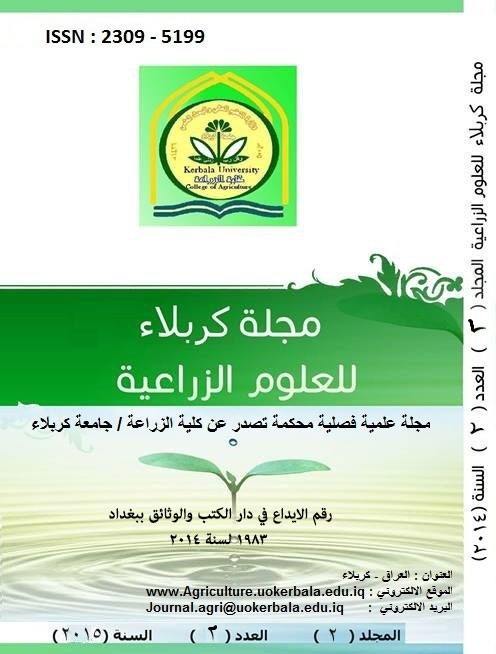Isolation and identification of some Fungi caused Broad bean root and crown root disease by some plant extracts and Bioagents Trichoderma viride in
العربية
DOI:
https://doi.org/10.59658/jkas.v2i4.68Abstract
A field survey was conducted in 15 Broad bean plant fields in Babylon province/Iraq in growth season 2014 this survey was to evalnate the incidence and severity of root and crown rot disease on Broad bean crop. The results showed that the disease was faund in all studied fields with varions incidence (between 40 to 100%) and severity between (26.7 to 75%). Additionally,the The results of isolation and indentification of the disease pathogens domenstreted a Variation in presence of different causal agents. For example,the pathogens Rhizoctonia solani , Fusarium solani and Macrophomina phaseolina wer the most existion in whole tested fields. Also, the molecular diagnosis of these three fungal pathogens using Polymerase Chain Reaction test showed that 12 isolates were belonging to R. solani and 9 isolates to M. phaseolina. However, tow isolatesof F. solani were not detected while 10 isolates were detected clearly. The pathogensity test of these three fungi showed a variation in germination prcentage of tested seeds and differentiontion in disease severity.As well as, the chemicals detection test of three different plant extracts (Cocklebur, Albizzia, Redrot pigwed) indicated to exiting active compounds that were capable in inhibiting the three pathogens growth. The extract of Cocklebur plant was the most effective one by inhibiting percentage F. solani (100%), R. solani (91.47%)and M. phaseolina (88.17%).furthermore, the bioagent Trichoderma viride showed high efficiency in inhibition of the three cusal agents .
Key words:Br oad bean, root rot, fungi, bacteria, growth standards
Downloads
Published
How to Cite
Issue
Section
License
Copyright (c) 2015 Copyright (c) 2024 is the Author's article. Published by the Journal of Kerbala for Agricultural Sciences under a CC BY 4.0 license

This work is licensed under a Creative Commons Attribution 4.0 International License.
Licensing Terms
All articles are published under a Creative Commons License and will be directed to the Creative Commons Attribution 4.0 International License (CC BY 4.0) That permits use, distribution, and reproduction in any medium, provided the original work is properly cited. This license also allows the work to be used for commercial purposes.
Use by both non-commercial and commercial users
This content is licensed under a Creative Commons Attribution 4.0 International (CC BY 4.0) license, permitting use by both non-commercial and commercial users. Individual users may access, download, copy, display, and redistribute the articles to colleagues, as well as adapt, translate, and text- and data-mine the content, subject to the following conditions:
- The author's moral rights, including the right of attribution and the right to protect their work from derogatory treatment, are respected.
- Where content in the article is identified as belonging to a third party, users must ensure that any reuse complies with the copyright policies of the owner of that content.
- If the article content is reused for research or educational purposes, users should maintain a link to the appropriate bibliographic citation, including the DOI and a link to the published version on the journal's website.

